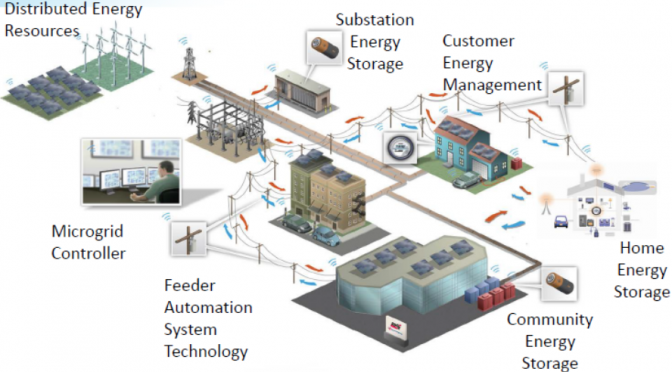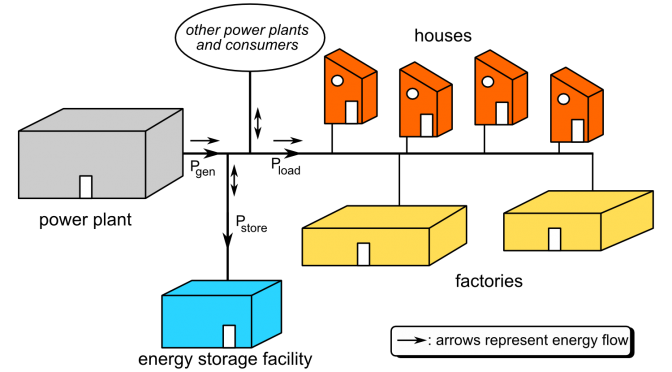The microgrid is a critical component for the U.S. and global energy economy. It is uniquely equipped to deliver electricity that is secure, reliable, affordable, and generated by preferred resources to consumers where they want it, when they want it, how they want it.

Our advanced microgrid solution ensures that operational and economic goals are realized while reliably meeting energy demand. We provide you with the flexibility to locally-manage your Microgrid or the option to have The Energy Group manage it for you.
The Energy Group’s microgrid solution uses the same tools,techniques and best practices that we use to support the operation of Balancing Authorities and vertically integrated utilities. The Energy Group, through its affiliates, operates a utility-scale Energy Management system (EMS) that integrates and optimizes grid assets, power generation assets and controllable loads.
These benefits are derived from automating the integration and optimized dispatch of various sources of Distributed Energy Resources (DERs), load control, and defining the interconnection relationship with the main transmission grid.


The Energy Group's strategic alliance partners use a Microgrid Management Suite (MMS) that allows you to take control over your Microgrid. Our user-friendly dashboard puts all the relevant information at your fingertips and enables you to view, change, and interact with the various functions on your Microgrid.

At the grid level, The Energy Group's strategic alliance partnerships uses powerful supervisory control and data acquisition (SCADA) and Energy Management Systems (EMS) to help customers optimize their entire energy infrastructure and interact with the grid at large. This can provide economic and reliability opportunities to your organization that might not otherwise be available. The Energy Group has years of experience managing Balancing Authorities and local Control Areas across the country and is well-positioned to help you get the most out your microgrid resources.

|
WHAT IS A MICROGRID?
|
|
|
A microgrid is a group of interconnected electrical loads and energy resources within a clearly defined electrical boundary that functions as a single controllable entity. A microgrid can connect and disconnect from the grid to enable it to operate in both grid-connected or island-mode as physical and/or economic conditions dictate. The Energy Group (TEG) takes a broad view when designing microgrid systems in order to most efficiently serve loads by integrating existing and complementary generation with innovative and interactive energy management systems. |
|
|
|
WHAT ARE THE BENEFITS?
|
 |
|
|---|---|
Microgrids require intelligent, automated systems that safely and reliably operate devices in the most efficient manner possible. Through The Energy Group’s strategic alliance partnerships, we have a portfolio of proven systems capable of managing a microgrid of any size and purpose.
TEG’s experts will help you determine the proper system depending on the size and complexity of your microgrid and your desired level of control. Once your microgrid is defined, our Microgrid Management Suite (MMS) of software tools will empower you to get the most out of it.


The Energy Group works with you to design and deliver a comprehensive, integrated microgrid solution that meets your needs. We have the ability to manage multiple energy sources, advanced control systems, and transmission and distribution assets utilizing a 24/7 Control Center. With years of real-time operations and energy management experience, we are well-positioned to design, implement, and operate microgrid solutions. Additionally, we have developed best practices for project management that enable projects to be delivered on time and on budget – an approach critical to our customers’ success.
During the Planning & Engineering step, TEG collects all relevant data and conducts extensive, on- site planning and engineering assessments. In this step, we will explore potential solutions in terms of their security, reliability, and environmental sustainability. Then, in coordination with our customer, we will refine the design and engineering details and financial requirements needed to meet our agreed upon objectives.
In this step, we will also evaluate Federal and State regulations, local utility policies, and other critical requirements, as they relate to the project. The Energy Group’s plan will address long-term operational targets, key performance indicators, compliance with regulatory requirements, and identification of partners that can facilitate the deployment of your microgrid.
Based upon the design and engineering details established in step 1, TEG evaluates potential equipment options and suppliers that satisfy project requirements and minimize technical, integration, and delivery risks. Step 2 also specifies roles and responsibilities, project milestones, and deliverables in order to meet customer objectives.
This step of the microgrid project consists of three sequential phases:
The Energy Group thoroughly tests all components of our microgrid systems to ensure that all equipment meets the required specifications and also that software and hardware systems are fully integrated and functioning as intended.
This step also involves on-site commissioning performed by our experienced engineers and system integrators.
Depending upon the project, this step may also involve strategic partners during commissioning if specialized equipment or software is used. Once all hardware and software is installed, we will thoroughly test the system and go through the site acceptance process with the customer.
Working with our customer and the implementation team, The Energy Group provides the customer with a secure portal to view and interact with the designed system. We also verify and validate the data used by the Microgrid Management Suite (MMS) to ensure data integrity and reliability.
The Energy Group works with the customer to ensure that the systems perform as designed. At this point, the Microgrid system is available for commercial operations.
 Electric Utilities
Electric Utilities
Utilities are well positioned to evaluate and implement new business models that support solutions and services in both regulated and unregulated markets. Renewable resource targets, regulatory mandates, critical loads, and aging infrastructure are strong business drivers for utilities to support their customers with distributed energy solutions, including microgrids.
 Munis, Co-ops & Cities
Munis, Co-ops & Cities
Local, state, and federal governments are creating incentives and programs for investment in microgrid systems. Localized energy generation and associated advanced control systems provide significant reliability, security and economic improvements for many cities and municipalities our nation. Energy reliability and resiliency against events that cause grid outages, regulatory changes, and cost effective solutions are driving communities throughout North America to consider microgrid solutions.
 Governments
Governments
Energy Security for mission critical facilities, aging infrastructure, energy cost reduction, renewable targets and emissions reductions are all drivers for military installations to invest in microgrid technology. Most federal bases currently have or are integrating on-site generation into a broad-scale energy infrastructure architecture that includes strong control and communications networks
 Commercial, University & Industrial
Commercial, University & Industrial
Reduced energy costs interest in securing renewable resources and on-site energy to enhance reliability, sustainability and for technology leadership purposes are all reasons that industrial and commercial campuses are looking for advanced microgrid solutions. As privately-owned and operated entities, many Commercial and Industrial customers recognize the value in technological solutions that provide value and avoid implementation barriers.